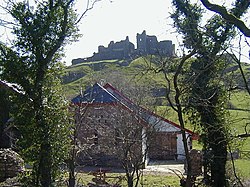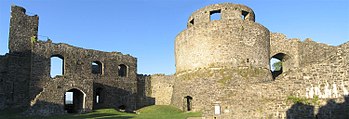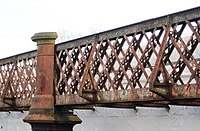Llandeilo: Difference between revisions
m clean up, typos fixed: a 19th century → a 19th-century |
No edit summary |
||
| Line 7: | Line 7: | ||
|latitude=51.884055 | |latitude=51.884055 | ||
|longitude=-3.999183 | |longitude=-3.999183 | ||
|population= | |population=1795 | ||
|post town=Llandeilo | |post town=Llandeilo | ||
|postcode=SA19 | |postcode=SA19 | ||
| Line 14: | Line 14: | ||
|constituency=Carmarthen East and Dinefwr | |constituency=Carmarthen East and Dinefwr | ||
}} | }} | ||
'''Llandeilo''' is a town in [[Carmarthenshire]], at the crossing of the [[River Towy]] by the A483 on a 19th-century stone bridge. The name was formerly written "Llandilo". | '''Llandeilo''' is a town in [[Carmarthenshire]], at the crossing of the [[River Towy]] by the A483 on a [[Llandeilo Bridge|19th-century stone bridge]]. The name was formerly written "Llandilo". | ||
The town's population was 1, | The town's population was 1,795 in 2011. It is adjacent to the westernmost point of the [[Brecon Beacons]] National Park. It is served by Llandeilo railway station on the Heart of Wales Line. | ||
The town | The ancient parish of '''Llandeilo Fawr''' extends into three hundreds: The town itself (Llandeilo Fawr Villa) along with Manerfabon, Taliaris, Tyr Escob and Rhosmaen lie in [[Perfedd]] hundred; Cwmcawrlwyd, Manordeilo, Tachloyan and Rhiwlas lie in [[Cayo Hundred]]; and Glynamman, Bryn-y-Beirdd, Pentre Cwm, Trecastle and Tregib lie in [[Iscennen]] hundred. | ||
==Early history== | ==Early history== | ||
Llandeilo is named after one of the better-known saints of the 6th century British church, Saint Teilo, and ''Llandeilo'' means "Teilo's Church". St Teilo, who was a contemporary of St David, established a small monastic settlement (''clas'') on the site of the present-day parish church. | Llandeilo is named after one of the better-known saints of the 6th-century British church, Saint Teilo, and ''Llandeilo'' means "Teilo's Church". St Teilo, who was a contemporary of St David, established a small monastic settlement (''clas'') on the site of the present-day parish church. | ||
Although there is very little factual detail about the life of Saint Teilo, the fact that he was highly respected in his lifetime, and revered after his death, is shown by the forty-five places dedicated to him, some as far afield as Brittany. | Although there is very little factual detail about the life of Saint Teilo, the fact that he was highly respected in his lifetime, and revered after his death, is shown by the forty-five places dedicated to him, some as far afield as Brittany. | ||
| Line 27: | Line 27: | ||
After Saint Teilo's death, two equally important ecclesiastical centres in Wales, namely [[Llandaff]] and [[St David's]], laid claim to his body. There is reasonable evidence to suggest, however, that Saint Teilo was buried in Llandeilo, where "he spent a solitary life gloriously". The parish church of Llandeilo Fawr (Great Llandeilo) is dedicated to Saint Teilo, and until 1880 its churchyard encompassed his baptistry. | After Saint Teilo's death, two equally important ecclesiastical centres in Wales, namely [[Llandaff]] and [[St David's]], laid claim to his body. There is reasonable evidence to suggest, however, that Saint Teilo was buried in Llandeilo, where "he spent a solitary life gloriously". The parish church of Llandeilo Fawr (Great Llandeilo) is dedicated to Saint Teilo, and until 1880 its churchyard encompassed his baptistry. | ||
The early Christian settlement that developed around the Church of Saint Teilo prospered, and by the early 9th century it had attained considerable ecclesiastical status as the seat of a Bishop-Abbot. The Church of St | The early Christian settlement that developed around the Church of Saint Teilo prospered, and by the early 9th century it had attained considerable ecclesiastical status as the seat of a Bishop-Abbot. The Church of St Teilo soon became a 'mother church' to the surrounding district, acquiring an extensive estate, and possessing one of the principality's most beautiful and finely illustrated manuscripts - the Gospel Book of Saint Teilo. The discovery of fragments of two large Celtic crosses from this period provide further testimony to Llandeilo's importance and indeed prestige as an early ecclesiastical centre. | ||
[[File:Dinefwr Castle.jpg|left|thumb|350px|Dinefwr Castle]] | [[File:Dinefwr Castle.jpg|left|thumb|350px|Dinefwr Castle]] | ||
Towards the end of the ninth century, the importance of Llandeilo as a spiritual centre had started to decline and the Gospel Book of St Teilo was removed to [[Lichfield]] where it became commonly known as the Lichfield Gospels or the Book of Saint Chad. The [[Diocese of Lichfield|Bishops of Lichfield]] still use this manuscript to swear allegiance to the Crown. | Towards the end of the ninth century, the importance of Llandeilo as a spiritual centre had started to decline and the Gospel Book of St Teilo was removed to [[Lichfield]] where it became commonly known as the Lichfield Gospels or the Book of Saint Chad. The [[Diocese of Lichfield|Bishops of Lichfield]] still use this manuscript to swear allegiance to the Crown. | ||
[[Dinefwr Castle]] (or Dynevor Castle) is a spectacular castle overlooking the River | [[Dinefwr Castle]] (or Dynevor Castle) is a spectacular castle overlooking the River Towy near the town. It lies on a ridge on the northern bank of the Towy, with a steep drop of several hundred feet to the river. Dinefwr was the chief seat of the kingdom of [[Deheubarth]] and the seat of Rhys ap Gruffydd, one of the early kings over most of Wales. The foundations of two Roman forts have been discovered in the grounds of the Dinefwr estate, which is in the custody of the [[National Trust for Places of Historic Interest or Natural Beauty|National Trust]]. The estate of Golden Grove lies near the town, and further away, the impressive Carreg Cennen castle, another princely stronghold. The remains of Talley Abbey can be seen six miles away to the north of the town. Ten miles further north are the remains of the Roman gold mines of [[Dolaucothi]], another National Trust property. | ||
==Middle Ages== | ==Middle Ages== | ||
In the centuries that followed the Norman Conquest, the [[Diocese of Llandaff|Bishop of Llandaff]] and [[Diocese of St David's|Bishop of St David's]] both claimed Llandeilo for their respective diocese. By the early 12th century Llandeilo came under the patronage of the Bishopric of St David's, an ecclesiastic borough which became responsible for the affairs of the town including its development as an important mediæval market centre to an extensive agricultural hinterland. | In the centuries that followed the Norman Conquest, the [[Diocese of Llandaff|Bishop of Llandaff]] and [[Diocese of St David's|Bishop of St David's]] both claimed Llandeilo for their respective diocese. By the early 12th century Llandeilo came under the patronage of the Bishopric of St David's, an ecclesiastic borough which became responsible for the affairs of the town including its development as an important mediæval market centre to an extensive agricultural hinterland. | ||
Until the middle of the 20th century, a fair called St | Until the middle of the 20th century, a fair called St Teilo's Fair, which had been authorised initially by Edward I in 1290, was held annually in the churchyard. Some of the agricultural produce and other goods offered for sale are recorded to have been displayed on the tombstones. Today, the fair has been replaced by a small farmers' market, held on the first Saturday of every month in the same place. | ||
==Llandeilo bridges== | ==Llandeilo bridges== | ||
| Line 44: | Line 44: | ||
==1987 rail disaster== | ==1987 rail disaster== | ||
In the Great Storm of 1987, the floods were so severe that the River | In the Great Storm of 1987, the floods were so severe that the River Towy overwhelmed the railway bridge crossing the river near Llandeilo. A schoolboy and three other people were drowned when the 05:27 train from [[Swansea]] to [[Shrewsbury]] crashed while crossing the bridge, and the bridge collapsed, dropping the train into the river. | ||
==Sport== | ==Sport== | ||
Latest revision as of 16:25, 24 December 2020
| Llandeilo | |
| Carmarthenshire | |
|---|---|
 Carreg Cennen Castle | |
| Location | |
| Grid reference: | SN625225 |
| Location: | 51°53’3"N, 3°59’57"W |
| Data | |
| Population: | 1,795 |
| Post town: | Llandeilo |
| Postcode: | SA19 |
| Dialling code: | 01558 |
| Local Government | |
| Council: | Carmarthenshire |
| Parliamentary constituency: |
Carmarthen East and Dinefwr |
Llandeilo is a town in Carmarthenshire, at the crossing of the River Towy by the A483 on a 19th-century stone bridge. The name was formerly written "Llandilo".
The town's population was 1,795 in 2011. It is adjacent to the westernmost point of the Brecon Beacons National Park. It is served by Llandeilo railway station on the Heart of Wales Line.
The ancient parish of Llandeilo Fawr extends into three hundreds: The town itself (Llandeilo Fawr Villa) along with Manerfabon, Taliaris, Tyr Escob and Rhosmaen lie in Perfedd hundred; Cwmcawrlwyd, Manordeilo, Tachloyan and Rhiwlas lie in Cayo Hundred; and Glynamman, Bryn-y-Beirdd, Pentre Cwm, Trecastle and Tregib lie in Iscennen hundred.
Early history
Llandeilo is named after one of the better-known saints of the 6th-century British church, Saint Teilo, and Llandeilo means "Teilo's Church". St Teilo, who was a contemporary of St David, established a small monastic settlement (clas) on the site of the present-day parish church.
Although there is very little factual detail about the life of Saint Teilo, the fact that he was highly respected in his lifetime, and revered after his death, is shown by the forty-five places dedicated to him, some as far afield as Brittany.
After Saint Teilo's death, two equally important ecclesiastical centres in Wales, namely Llandaff and St David's, laid claim to his body. There is reasonable evidence to suggest, however, that Saint Teilo was buried in Llandeilo, where "he spent a solitary life gloriously". The parish church of Llandeilo Fawr (Great Llandeilo) is dedicated to Saint Teilo, and until 1880 its churchyard encompassed his baptistry.
The early Christian settlement that developed around the Church of Saint Teilo prospered, and by the early 9th century it had attained considerable ecclesiastical status as the seat of a Bishop-Abbot. The Church of St Teilo soon became a 'mother church' to the surrounding district, acquiring an extensive estate, and possessing one of the principality's most beautiful and finely illustrated manuscripts - the Gospel Book of Saint Teilo. The discovery of fragments of two large Celtic crosses from this period provide further testimony to Llandeilo's importance and indeed prestige as an early ecclesiastical centre.

Towards the end of the ninth century, the importance of Llandeilo as a spiritual centre had started to decline and the Gospel Book of St Teilo was removed to Lichfield where it became commonly known as the Lichfield Gospels or the Book of Saint Chad. The Bishops of Lichfield still use this manuscript to swear allegiance to the Crown.
Dinefwr Castle (or Dynevor Castle) is a spectacular castle overlooking the River Towy near the town. It lies on a ridge on the northern bank of the Towy, with a steep drop of several hundred feet to the river. Dinefwr was the chief seat of the kingdom of Deheubarth and the seat of Rhys ap Gruffydd, one of the early kings over most of Wales. The foundations of two Roman forts have been discovered in the grounds of the Dinefwr estate, which is in the custody of the National Trust. The estate of Golden Grove lies near the town, and further away, the impressive Carreg Cennen castle, another princely stronghold. The remains of Talley Abbey can be seen six miles away to the north of the town. Ten miles further north are the remains of the Roman gold mines of Dolaucothi, another National Trust property.
Middle Ages
In the centuries that followed the Norman Conquest, the Bishop of Llandaff and Bishop of St David's both claimed Llandeilo for their respective diocese. By the early 12th century Llandeilo came under the patronage of the Bishopric of St David's, an ecclesiastic borough which became responsible for the affairs of the town including its development as an important mediæval market centre to an extensive agricultural hinterland.
Until the middle of the 20th century, a fair called St Teilo's Fair, which had been authorised initially by Edward I in 1290, was held annually in the churchyard. Some of the agricultural produce and other goods offered for sale are recorded to have been displayed on the tombstones. Today, the fair has been replaced by a small farmers' market, held on the first Saturday of every month in the same place.
Llandeilo bridges
The road and railway bridges over the River Towy are of engineering interest. The railway bridge, opened in 1852, is a rare survival of an early 'Town-type' lattice girder truss.

1987 rail disaster
In the Great Storm of 1987, the floods were so severe that the River Towy overwhelmed the railway bridge crossing the river near Llandeilo. A schoolboy and three other people were drowned when the 05:27 train from Swansea to Shrewsbury crashed while crossing the bridge, and the bridge collapsed, dropping the train into the river.
Sport
- Rugby Union: Llandeilo RFC, one of the founding clubs of the Welsh Rugby Union
- Football: Llandeilo AFC
Miscellany
- Llandeilo hosted the National Eisteddfod in 1996, held on the meadow across the river at Ffairfach.
- Llandeilo also hosted the 2008 World Sheepdog Trials.
- Near Llandeilo, at Pant-y-llyn, is Great Britain's only known turlough (or ephemeral lake).
- At one time Llandeilo produced its own 'Llandeilo Style' banknotes, and this is recorded on a blue plaque on the wall of the building which used to house the Bank of the Black Ox
Outside links
- Visit Llandeilo
- Comprehensive history of Llandeilo
- Llandeilo town council
- Virtual Llandeilo
- Llandeilo info
- www.geograph.co.uk : photos of Llandeilo and surrounding area